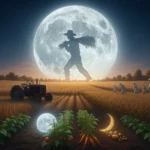The Moon and agriculture have been deeply connected for millennia. From ancient civilizations to today’s organic and biodynamic farms, the moon has long been viewed as a natural calendar and celestial guide for planting, harvesting, and managing crops.
Before artificial light, farmers relied on the moon’s phases and brightness to plan their agricultural work. Seasonal full moons acted as reliable signals of shifting weather and planting cycles—each one named for the crops or natural changes it marked. Examples include the Strawberry Moon in June, when berries ripen, and the Flower Moon in May, signaling a season of vibrant growth.
Among all lunar markers, the Harvest Moon is the most famous in agriculture. Occurring closest to the autumnal equinox, typically in September or early October, it played a critical role for farmers racing against time.
Usually, the moon rises about 50 minutes later each night, but around the Harvest Moon, that delay shortens dramatically. For several evenings in a row, it rises just after sunset, providing bright, early moonlight that allows farmers to continue working into the night.
This extra light made it possible to harvest crops like corn, wheat, and grains before frost set in—acting as nature’s headlamp. Historically, this moon helped secure entire communities’ winter food stores, with the Hunter’s Moon following soon after to aid hunters and gatherers in their final seasonal preparations.
Beyond light, traditional farmers believed the moon’s gravitational pull influenced plant growth much like it affects ocean tides. This practice, often called lunar farming or planting by the moon, divided the month into two key cycles:
From New Moon to Full Moon, the moon’s growing brightness and gravitational strength are thought to draw moisture upward, encouraging vigorous leaf and stem growth. Farmers traditionally planted above-ground crops such as beans, tomatoes, and leafy greens during this phase.
From Full Moon to New Moon, as light decreases, energy is believed to move downward into the soil and roots. This period is considered ideal for root vegetables like potatoes and carrots, as well as for weeding and pruning, and storing harvests, as lower sap flow improves preservation.
While often regarded as folklore, this lunar planting method remains popular in biodynamic agriculture and is still featured in resources like The Old Farmer’s Almanac, which continues to publish lunar gardening calendars.
Cultures worldwide have assigned distinct names to the seasonal moons, reflecting agricultural milestones and natural cycles:
From Native American tribes to Celtic and Anglo-Saxon farmers, lunar calendars served as essential tools for organizing planting, sowing, and harvesting activities. These traditions evolved into the almanacs and agricultural calendars still referenced today.
Even in modern agriculture—with satellite forecasting and precision irrigation—the moon’s cycles continue to hold practical and symbolic value.
Farmers and gardeners who follow lunar rhythms often describe improved soil health and timing efficiency, while biodynamic farmers view the moon as a partner in balancing cosmic and earthly energies.
Ultimately, the connection between the Moon and agriculture represents humanity’s enduring relationship with the rhythms of nature. These ancient patterns remind us that even as technology advances, some of the oldest agricultural tools remain the most timeless.






